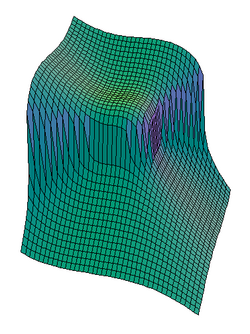Fermat curve
In mathematics, the Fermat curve is the algebraic curve in the complex projective plane defined in homogeneous coordinates (X:Y:Z) by the Fermat equation:
- [math]\displaystyle{ X^n + Y^n = Z^n.\ }[/math]
Therefore, in terms of the affine plane its equation is:
- [math]\displaystyle{ x^n + y^n = 1.\ }[/math]
An integer solution to the Fermat equation would correspond to a nonzero rational number solution to the affine equation, and vice versa. But by Fermat's Last Theorem it is now known that (for n > 2) there are no nontrivial integer solutions to the Fermat equation; therefore, the Fermat curve has no nontrivial rational points.
The Fermat curve is non-singular and has genus:
- [math]\displaystyle{ (n - 1)(n - 2)/2.\ }[/math]
This means genus 0 for the case n = 2 (a conic) and genus 1 only for n = 3 (an elliptic curve). The Jacobian variety of the Fermat curve has been studied in depth. It is isogenous to a product of simple abelian varieties with complex multiplication.
The Fermat curve also has gonality:
- [math]\displaystyle{ n-1.\ }[/math]
Fermat varieties
Fermat-style equations in more variables define as projective varieties the Fermat varieties.
Related studies
- Baker, Matthew; Gonzalez-Jimenez, Enrique; Gonzalez, Josep; Poonen, Bjorn (2005), "Finiteness results for modular curves of genus at least 2", American Journal of Mathematics 127 (6): 1325–1387, doi:10.1353/ajm.2005.0037
- Gross, Benedict H.; Rohrlich, David E. (1978), "Some Results on the Mordell-Weil Group of the Jacobian of the Fermat Curve", Inventiones Mathematicae 44 (3): 201–224, doi:10.1007/BF01403161, http://www.kryakin.com/files/Invent_mat_%282_8%29/44/44_01.pdf
- Klassen, Matthew J.; Debarre, Olivier (1994), "Points of Low Degree on Smooth Plane Curves", Journal für die reine und angewandte Mathematik 1994 (446): 81–88, doi:10.1515/crll.1994.446.81
- Tzermias, Pavlos (2004), "Low-Degree Points on Hurwitz-Klein Curves", Transactions of the American Mathematical Society 356 (3): 939–951, doi:10.1090/S0002-9947-03-03454-8
 |


